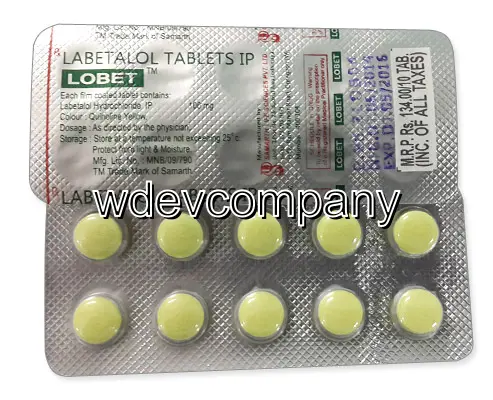| Package | Dosage | Price | Price per Dose | |
|---|---|---|---|---|
| Dosage: 50mg | ||||
| 180 pill | 50mg | $439.23 | $2.44 | |
| 120 pill | 50mg | $296.92 | $2.48 | |
| 90 pill | 50mg | $224.88 | $2.49 | |
| 60 pill | 50mg | $151.08 | $2.51 | |
| 30 pill | 50mg | $77.29 | $2.58 | |
| Dosage: 100mg | ||||
| 180 pill | 100mg | $913.62 | $5.08 | |
| 120 pill | 100mg | $671.16 | $5.59 | |
| 90 pill | 100mg | $553.44 | $6.15 | |
| 60 pill | 100mg | $405.85 | $6.76 | |
| 30 pill | 100mg | $223.12 | $7.43 | |
| Dosage: 200mg | ||||
| 120 pill | 200mg | $1,219.34 | $10.16 | |
| 90 pill | 200mg | $1,004.99 | $11.16 | |
| 60 pill | 200mg | $737.92 | $12.30 | |
| 180 pill | 200mg | $560.47 | $3.11 | |
| 30 pill | 200mg | $405.85 | $13.53 | |

Labetalol Description
Overview of Labetalol
Labetalol is a medication commonly used to manage high blood pressure and control hypertension. It belongs to a class of drugs known as beta-blockers, which work by blocking specific receptors in the body to reduce heart rate and dilate blood vessels. This dual action helps to lower blood pressure effectively and maintain cardiovascular stability. Labetalol is available in both oral and injectable forms, making it versatile for various clinical situations.
Mechanism of Action
The primary function of Labetalol is to block beta-adrenergic receptors in the heart, lungs, and vascular smooth muscle. By doing so, it reduces the force and rate of heart contractions. Additionally, it also blocks alpha-adrenergic receptors, leading to vasodilation, which decreases peripheral vascular resistance. This combined beta and alpha-blocking effect makes Labetalol particularly effective for lowering blood pressure without causing significant constriction of blood vessels or severe reduction in heart rate, which can sometimes occur with other beta-blockers.
Uses and Indications
Labetalol is prescribed mainly for the treatment of hypertension, especially when rapid blood pressure reduction is required. It is often used in hypertensive emergencies and in pregnant women with high blood pressure, as it is considered safe and effective in such cases. Besides managing hypertension, Labetalol can be used to prevent angina (chest pain), manage certain heart rhythm disorders, and control blood pressure during anesthesia procedures. Its ability to quickly and effectively reduce blood pressure makes it a valuable medication in various clinical settings.
Benefits and Potential Side Effects
One of the advantages of Labetalol is its combined alpha and beta-blocking activity, providing a smoother blood pressure control with fewer side effects. Patients often tolerate it well, and it offers rapid onset of action when administered intravenously. However, like all medications, Labetalol may cause side effects. Commonly reported issues include dizziness, fatigue, nausea, and headache. Some patients may experience a slow heart rate or low blood pressure. Less frequently, allergic reactions or gastrointestinal discomfort can occur. It is essential for users to communicate with their healthcare provider about any adverse symptoms experienced during treatment.
Precautions and Recommendations
Before starting Labetalol, individuals should inform their healthcare provider about any existing medical conditions, particularly asthma, heart failure, or severe peripheral vascular disease. Because Labetalol affects heart rate and blood pressure, regular monitoring is recommended during therapy. Pregnant and breastfeeding women should discuss the benefits and risks with their doctor, as Labetalol is often considered safe in pregnancy when properly supervised. Patients are advised not to suddenly stop taking the medication, as this could lead to a sudden increase in blood pressure or worsening of certain heart conditions. Adherence to dosing instructions and routine medical check-ups are essential for safe and effective therapy.
